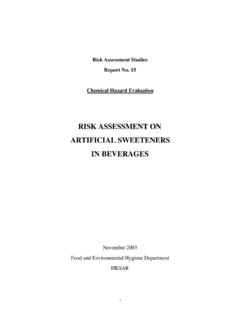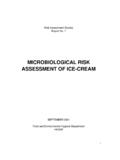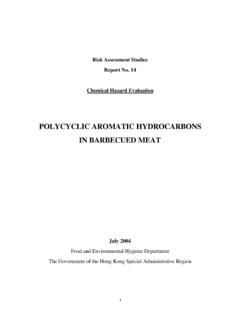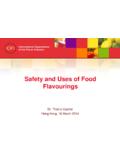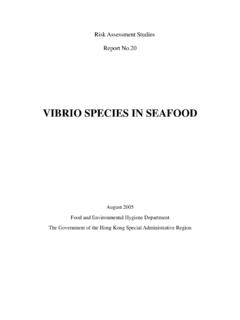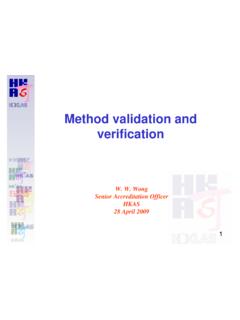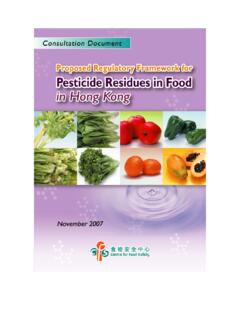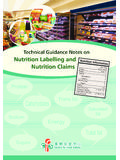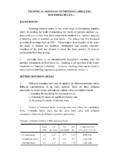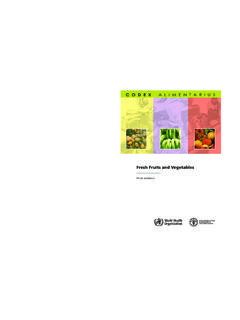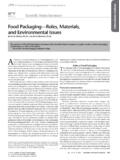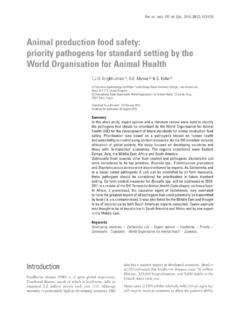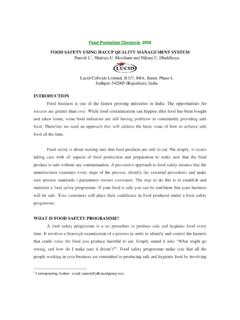Transcription of Safety and Uses of Food Flavourings - cfs.gov.hk
1 Safety and Uses of Food Flavourings Dr. Thierry Cachet Hong Kong, 16 March 2014 2 Outline of the Presentation IOFI Mission & Responsibilities Challenges for Regulating Flavourings codex alimentarius Guideline for the Use of Flavourings (CAC/GL 66-2008) IOFI Code of Practice (2010) JECFA Evaluations of Flavourings The IOFI Global Reference List 3 IOFI Established in 1969 to be the global voice of the flavor industry Not-for-profit Association of Associations and Companies Headquarters in Geneva (Switzerland) and operations in Brussels (Belgium) and in Washington DC (USA) IOFI is a Non-Governmental Organization with Observer Status at the WHO/FAO codex alimentarius Commission and its subsidiary bodies 4 Membership Associations Ordinary Association Members Regional or national trade associations of companies active in the manufacture and sales of flavor ingredients EFFA (Europe)*; FEMA (USA); JFFMA (Japan); ABIFRA (Brazil); ANFPA (Mexico); ANDI (Colombia) *EFFA is a regional association grouping the associations of A, BE, CH, D, DK, F, I, NL, SE, S, T, UK Corresponding Association Members (Non Voting) Regional or national trade associations that are early in their development AFFI (Indonesia); CAFEPA (Argentina), FAANZ (Australia/New Zealand).
2 FFAS (Singapore); KFFA (Korea); FMAC (Canada); SAAFFI (South-Africa); (CAFFCI (China) is in the process of joining) 5 Membership Companies Ordinary Company Members Flavor companies that are a member of national associations in at least three different regions* Firmenich, Givaudan, Hasegawa, IFF, Mane, Robertet, Sensient, Symrise, Takasago, Wild *Identified regions are North America, Latin America, Europe and Far East 6 IOFI Mission The International Organization of the Flavor Industry represents the interests of the global flavor industry and its partners by providing leadership in Safety , scientific and regulatory matters. 7 IOFI Roles and Responsibilities The safe use of flavorings is the flavor industry s first priority, in order to prevent risk to the health of consumers, employees and the environment.
3 Acting in partnership with its members, IOFI provides sound scientific information to the industry, its customers, and government agencies in order to promote the benefits and safe use of flavors. More Info on IOFI: 8 REGULATING Flavourings : A CHALLENGE! The public must have confidence that their food supply is safe. Food legislation and regulations are designed to ensure that consumer s food is safe and free of deception. Flavourings are an essential component of foods All food ultimately contains Flavourings , whether naturally present or added The complexity of added Flavourings constitutes a major challenge for the regulator 9 Flavouring Substances Food Additives Most occur naturally in Food Single substances must be used with many others.
4 Single substances can be used to contribute to many different flavour tonalities (effects). Flavouring substances are used at low levels self limiting = consumer can usually detect overdose. Consumers expect Flavourings to taste like those of recognizable foods so flavouring substances must be at similar concentration as found in Nature. > 3000+ single flavouring substances listed Majority are not naturally occurring in Food Usually only one technological effect ( Antioxidant, Preservative, Emuslifier ..) with an optimum addition level Usually not self-limiting = consumer will not be able to detect overdose Limited number 10-20 per technological effect 10 Flavourings : single substances and complex materials Single, chemically defined, substances Preparations, complexes, complex materials Substances that are natural or synthetic Essential oils, extracts and oleoresins from botanical/natural origin Usually compounded (mixed) to form formulated Flavourings Compounded or used as is Citral, benzaldehyde.
5 Lemongrass, Bitter almond oil 11 Traditional definitions for flavouring* Natural Nature - Identical Artificial Flavouring substances * codex Food Additives and Contaminants (CCFAC) 1972 / codex Food Labelling (CCFL) - 1985 12 Formulation of Compounded Flavourings Single, chemically-defined substances (from a few to over 50 or more substances that are natural or synthetic) and/or a natural flavouring complex ( essential oil, oleoresin, extracts) are mixed. + Food additives (stabilizers, emulsifiers, antioxidants, preservatives,..) + Carrier(s) (food additive, food ingredient, ) added Example*: Formula of a Confectionery (Vanilla) Flavouring designed to be used at the rate of to in the finished product.
6 Maltol Dihydrocoumarin Vanillin Ethylvanillin Heliotropin Cinnamon bark oil Water Propylene glycol ad *Food Flavourings (Ed. P. R. Ashurst) Blackie - 1991 13 Supply Chain for Creation Manufacturing Food Production Food Consumption Formula developed containing approved flavouring substances, extracts, essential oils, + food additives and carriers/solvents Flavouring is manufactured and shipped to the food producer as a concentrated mixture of ingredients Food product is manufactured containing % of the flavouring in the final product Consumer purchases the food product and consumes it 14 codex alimentarius Food Additives Definition Food additive means any substance not normally consumed as a food by itself and not normally used as a typical ingredient of the food, whether or not it has nutritive value.
7 The intentional addition of which to food for a technological (including organoleptic) purpose in the manufacture, processing, preparation, treatment, packing, packaging, transport or holding of such food results, or may reasonably expected to result, (directly or indirectly) in it or its by-products becoming a component of or otherwise affecting the characteristics of such foods. ( codex alimentarius Commission Procedural Manual, page 22, 21th Ed., 2013) 15 Flavourings in the codex alimentarius Hence, Flavourings are considered as food additives in the codex standards, However, the General Standard on Food Additives (GSFA) ( codex STAN 192-1995) does not specifically deal with flavouring substances. Moreover, Flavourings have no INS additive number!
8 See Introduction of CAC/GL 36-1989 (Class Names and the International Numbering System for Food Additives): The INS does not include Flavourings , which have a JECFA number as identifier JECFA has completed the Safety evaluation of many chemically- defined flavouring substances- so far more than 2186 substances were evaluated. At the next JECFA meeting (June 2014) an additional 28 substances will be evaluated. A clear need to clarify the codex status of Flavourings ! 16 Development of a codex Guideline on the Use of Flavourings At the 37th meeting (2005) of the codex Committee on Food Additives (CCFA) it was decided to develop a codex Guideline for the Use of Flavourings , that establishes safe conditions of use for Flavourings in food similar to the principles for the safe use of food additives contained in the GSFA, and with a reference to the evaluations completed by JECFA.
9 The 38th meeting (2006) of the CCFA: start of drafting work. At the 40th meeting (2008) the CCFA completed the work and proposed adoption by the codex alimentarius Commission. Published in codex alimentarius as codex Guideline for the Use of Flavourings (CAC/GL 66-2008). 17 Consequences of CAC/GL 66-2008 Flavourings are products that are added to food to impart, modify, or enhance the flavour of food (with the exception of flavour enhancers considered as food additives under the codex Class Names and the International Numbering System for Food Additives-CAC/GL 36-1989). Flavourings do not include substances that have an exclusively sweet, sour, or salty taste ( sugar, vinegar, and table salt). Flavourings may consist of flavouring substances, natural flavouring complexes, thermal process Flavourings or smoke Flavourings and mixtures of them and may contain non-flavouring food ingredients.
10 They are not intended to be consumed as such. (Definition of CAC/GL 66-2008) Flavour is the sum of those characteristics of any material taken in the mouth, perceived principally by the senses of taste and smell, and also the general pain and tactile receptors in the mouth, as received and interpreted by the brain. The perception of flavour is a property of Flavourings (Definition ) Non-flavouring food ingredients are food ingredients, such as food additives and foodstuffs that can be added to Flavourings and are necessary for dissolving, dispersing, or diluting Flavourings , or are necessary for the production, storage, handling and use of Flavourings . (Definition ) 18 codex Guidelines: a Paradigm Shift Natural Nature identical Artificial ORIGIN Physical or Biochemical process Synthetic origin Natural ORIGIN Physical or Biochemical process Synthetic Chemical process 19 Conclusions- codex Guideline CAC/GL 66-2008 Expands and clarifies the definition(s) of Flavourings .
